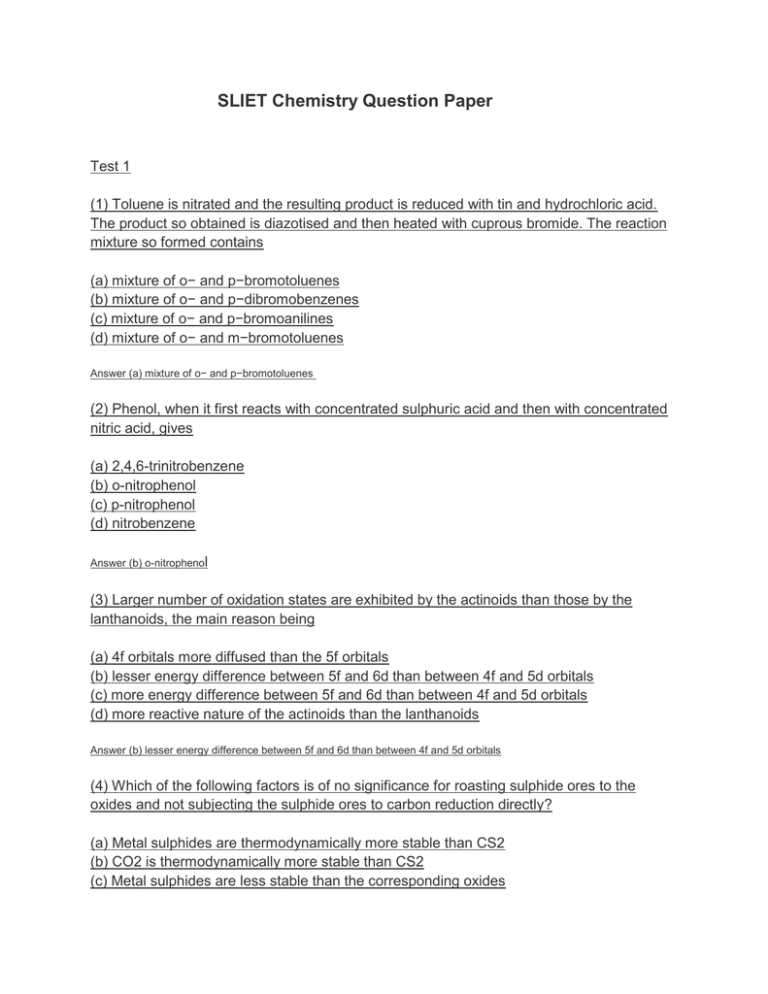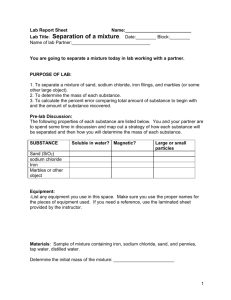SLIET Chemistry Question Paper
advertisement

SLIET Chemistry Question Paper Test 1 (1) Toluene is nitrated and the resulting product is reduced with tin and hydrochloric acid. The product so obtained is diazotised and then heated with cuprous bromide. The reaction mixture so formed contains (a) mixture of o− and p−bromotoluenes (b) mixture of o− and p−dibromobenzenes (c) mixture of o− and p−bromoanilines (d) mixture of o− and m−bromotoluenes Answer (a) mixture of o− and p−bromotoluenes (2) Phenol, when it first reacts with concentrated sulphuric acid and then with concentrated nitric acid, gives (a) 2,4,6-trinitrobenzene (b) o-nitrophenol (c) p-nitrophenol (d) nitrobenzene Answer (b) o-nitrophenol (3) Larger number of oxidation states are exhibited by the actinoids than those by the lanthanoids, the main reason being (a) 4f orbitals more diffused than the 5f orbitals (b) lesser energy difference between 5f and 6d than between 4f and 5d orbitals (c) more energy difference between 5f and 6d than between 4f and 5d orbitals (d) more reactive nature of the actinoids than the lanthanoids Answer (b) lesser energy difference between 5f and 6d than between 4f and 5d orbitals (4) Which of the following factors is of no significance for roasting sulphide ores to the oxides and not subjecting the sulphide ores to carbon reduction directly? (a) Metal sulphides are thermodynamically more stable than CS2 (b) CO2 is thermodynamically more stable than CS2 (c) Metal sulphides are less stable than the corresponding oxides (d) CO2 is more volatile than CS2 Answer (a) Metal sulphides are thermodynamically more stable than CS2 (5) α-D-(+)-glucose and β-D-(+)-glucose are (a) conformers (b) epimers (c) anomers (d) enantiomers Answer (c) anomers (6) Which one of the following is the correct statement? (a) Boric acid is a protonic acid (b) Beryllium exhibits coordination number of six (c) Chlorides of both beryllium and aluminium have bridged chloride structures in solid phase (d) B2H6.2NH3 is known as ‘inorganic benzene’ Answer (c) Chlorides of both beryllium and aluminium have bridged chloride structures in solid phase (7) Among the following substituted silanes the one which will give rise to cross linked silicone polymer on hydrolysis is (a) R4Si (b) RSiCl3 (c) R2SiCl2 (d) R3SiCl Answer (b) RSiCl3 (8) In a compound atoms of element Y from ccp lattice and those of element X occupy 2/3rd of tetrahedral voids. The formula of the compound will be (a) X4Y3 (b) X2Y3 (c) X2Y (d) X3Y4 Answer (a) X4Y3 (9) Amount of oxalic acid present in a solution can be determined by its titration with KMnO4 solution in the presence of H2SO4. The titration gives unsatisfactory result when carried out in the presence of HCl, because HCl (a) gets oxidised by oxalic acid to chlorine (b) furnishes H+ ions in addition to those from oxalic acid (c) reduces permanganate to Mn2+ (d) oxidises oxalic acid to carbon dioxide and water Answer (c) reduces permanganate to Mn2+ (10) Which one of the following pairs of species have the same bond order? (a) CN− and NO+ (b) CN− and CN+ (c) O− and CN− (d) NO+ and CN+ Answer (a) CN− and NO+ 11) A reaction was found to be second order with respect to the concentration of carbon monoxide. If the concentration of carbon monoxide is doubled, with everything else kept the same, the rate of reaction will (a) remain unchanged (b) triple (c) increase by a factor of 4 (d) double Answer (c) increase by a factor of 4 (12) HBr reacts with CH2 = CH – OCH3 under anhydrous conditions at room temperature to give (a) CH3CHO and CH3Br (b) BrCH2CHO and CH3OH (c) BrCH2 – CH2 – OCH3 (d) H3C – CHBr – OCH3 Answer (d) H3C – CHBr – OCH3 (13) The IUPAC name for the complex [Co(NO2)(NH3)5]Cl2 is (a) nitrito-N-pentaamminecobalt (III) chloride (b) nitrito-N-pentaamminecobalt (II) chloride (c) pentaammine nitrito-N-cobalt (II) chloride (d) pentaammine nitrito-N-cobalt (III) chloride Answer (d) pentaammine nitrito-N-cobalt (III) chloride (14) The term anomers of glucose refers to (a) isomers of glucose that differ in configurations at carbons one and four (C-1 and C-4) (b) a mixture of (D)-glucose and (L)-glucose (c) enantiomers of glucose (d) isomers of glucose that differ in configuration at carbon one (C-1) Answer (d) isomers of glucose that differ in configuration at carbon one (C-1) (15) Phenyl magnesium bromide reacts with methanol to give (a) a mixture of anisole and Mg(OH)Br (b) a mixture of benzene and Mg(OMe)Br (c) a mixture of toluene and Mg(OH)Br (d) a mixture of phenol and Mg(Me)Br Answer (b) a mixture of benzene and Mg(OMe)Br (16) The pyrimidine bases present in DNA are (a) cytosine and adenine (b) cytosine and guanine (c) cytosine and thymine (d) cytosine and uracil Answer (c) cytosine and thymine (17) Among the following mixtures, dipole-dipole as the major interaction, is present in (a) benzene and ethanol (b) acetonitrile and acetone (c) KCl and water (d) benzene and carbon tetrachloride Answer (b) acetonitrile and acetone (18) Fluorobenzene (C6H5F) can be synthesized in the laboratory (a) by heating phenol with HF and KF (b) from aniline by diazotisation followed by heating the diazonium salt with HBF4 (c) by direct fluorination of benzene with F2 gas (d) by reacting bromobenzene with NaF solution Answer (b) from aniline by diazotisation followed by heating the diazonium salt with HBF4 (19) A metal, M forms chlorides in its +2 and +4 oxidation states. Which of the following statements about these chlorides is correct? (a) MCl2 is more volatile than MCl4 (b) MCl2 is more soluble in anhydrous ethanol than MCl4 (c) MCl2 is more ionic than MCl4 (d) MCl2 is more easily hydrolysed than MCl4 Answer (c) MCl2 is more ionic than MCl4 (20) Which of the following statements is true? (a) H3PO3 is a stronger acid than H2SO3 (b) In aqueous medium HF is a stronger acid than HCl (c) HClO4 is a weaker acid than HClO3 (d) HNO3 is a stronger acid than HNO2 Answer (d) HNO3 is a stronger acid than HNO2 (21) In which of the following molecules/ions are all the bonds not equal? (a) SF4 (b) SiF4 (c) XeF4 (d) 4 BF− Answer (a) SF4 (22) Which one of the following sets of ions represents a collection of isoelectronic species? (a) K+ , Cl–, Ca2+, Sc3+ (b) Ba2+, Sr2+, K+, S2– (c) N3–, O2–, F–, S2– (d) Li+, Na+, Mg2+, Ca2+ Answer (a) K+ , Cl–, Ca2+, Sc3+ (23) What products are expected from the disproportionation reaction of hypochlorous acid? (a) HClO3 and Cl2O (b) HClO2 and HClO4 (c) HCl and Cl2O (d) HCl and HClO3 Answer (d) HCl and HClO3 (24) In Fe(CO)5, the Fe – C bond possesses (a) π-character only (b) both σ and π characters (c) ionic character (d) σ-character only Answer (b) both σ and π characters (25) Lanthanoid contraction is caused due to (a) the appreciable shielding on outer electrons by 4f electrons from the nuclear charge (b) the appreciable shielding on outer electrons by 5d electrons from the nuclear charge (c) the same effective nuclear charge from Ce to Lu (d) the imperfect shielding on outer electrons by 4f electrons from the nuclear charge Answer (d) the imperfect shielding on outer electrons by 4f electrons from the nuclear charge (26) In Langmuir’s model of adsorption of a gas on a solid surface (a) the rate of dissociation of adsorbed molecules from the surface does not depend on the surface covered (b) the adsorption at a single site on the surface may involve multiple molecules at the same time (c) the mass of gas striking a given area of surface is proportional to the pressure of the gas (d) the mass of gas striking a given area of surface is independent of the pressure of the gas Answer (c) the mass of gas striking a given area of surface is proportional to the pressure of the gas (27) Rate of a reaction can be expressed by Arrhenius equation as: k = Ae−E/RT (where E/RT is read as power of e) In this equation, E represents (a) the energy above which all the colliding molecules will react (b) the energy below which colliding molecules will not react (c) the total energy of the reacting molecules at a temperature, T (d) the fraction of molecules with energy greater than the activation energy of the reaction Answer (b) the energy below which colliding molecules will not react (28) Reaction of trans-2-phenyl-1-bromocyclopentane on reaction with alcoholic KOH produces (a) 4-phenylcyclopentene (b) 2-phenylcyclopentene (c) 1-phenylcyclopentene (d) 3-phenylcyclopentene Answer (d) 3-phenylcyclopentene (29) Increasing order of stability among the three main conformations (i.e. Eclipse, Anti, Gauche) of 2-fluoroethanol is (a) Eclipse, Gauche, Anti (b) Gauche, Eclipse, Anti (c) Eclipse, Anti, Gauche (d) Anti, Gauche, Eclipse Answer (c) Eclipse, Anti, Gauche (30) Following statements regarding the periodic trends of chemical reactivity of the alkali metals and the halogens are given. Which of these statements gives the correct picture? (a) The reactivity decreases in the alkali metals but increases in the halogens with increase in atomic number down the group (b) In both the alkali metals and the halogens the chemical reactivity decreases with increase in atomic number down the group (c) Chemical reactivity increases with increase in atomic number down the group in both the alkali metals and halogens (d) In alkali metals the reactivity increases but in the halogens it decreases with increase in atomic number down the group Answer (d) In alkali metals the reactivity increases but in the halogens it decreases with increase in atomic number down the group


